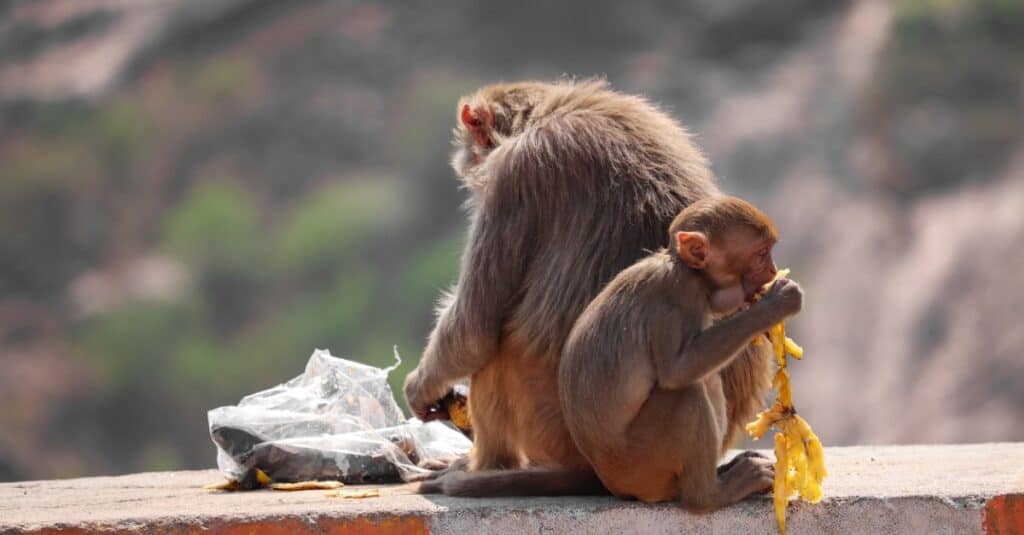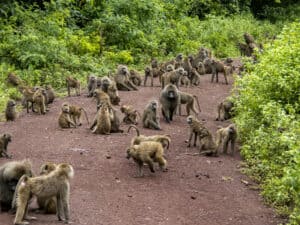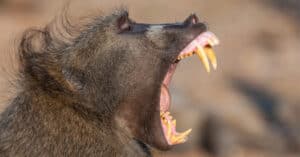Baboons are members of the primate family, and there are six species located across Africa. Ranging from 31 lbs to 88 lbs, each species of baboon has its own specialized region and diet. Although they are terrestrial, they sleep in trees, and much of their diet comes from the canopy. Let’s learn a bit about what baboons eat.
What do baboons eat?

Baboons are omnivores that eat grasses, seeds, roots, fruit, insects, mammals, birds, and even other monkeys.
©Thomas Netsch / Public domain, from Wikimedia Commons, the free media repository – License
Baboons eat grasses, roots, seeds, fruits, fungus, insects, mammals, birds, smaller monkeys, and shellfish.
True omnivores, baboons will eat almost anything they can get their hands on. As primates (like humans), baboons can eat everything from vegetation to meat. Known as “opportunistic feeders,” baboons forage through the day and eat whatever they happen to come across. They are irregularly active and forage through the day and occasionally at night.
Baboons forage, mostly looking for food sources as opposed to hunting like a predator might. When it comes to vegetation, baboons are known to eat grasses, roots, tubers, fruits, nuts, and vegetables. Although they are omnivores, most of their nutrition comes from these sorts of vegetation sources.
Still, baboons have no qualms about eating meat. Aside from vegetation, baboons will eat insects, rodents, fish, shellfish, birds, smaller monkeys, and even baby antelopes. Since they are so intelligent, traditionally tough foods to eat like shellfish can be consumed with many baboons using tools to aid in their foraging.
Additionally, baboons often live in close proximity to humans. As a result, baboons, ever the opportunist, will go through trash dumps, break into cars, and even sneak into homes looking for food. In some cases, whole troops of baboons will stage raids on farms, eating crops and hunting the chickens, goats, and sheep for meat.
A complete list of foods baboons eat
Here is a complete list of the common foods baboons will eat:
- grasses
- roots
- tubers
- seeds
- nuts
- fruits
- bark
- fungus
- insects
- spiders
- worms
- fish
- shellfish
- mice and other small mammals
- othe monkeys
- birds
- human resources (farms and trash)
Although baboons can eat almost anything, most of their diet comes from grasses and other vegetation.
Can baboons use tools to get their food?
Baboons are incredibly intelligent and use their brains as they forage.
As one of their primary food sources, grasses are relatively easy to come by in many of the habitats that baboons are found. Acquiring grass is as easy as seeing it and plucking it from the ground for most baboons. Although baboons eat grass, they can’t entirely live on it alone. Without a rumen (a specialized stomach organ) to break down the grasses, it’s difficult to extract all of the needed nutrients to survive, specifically protein.
To supplement, baboons will forage constantly. Another major food source is insects. There are accounts of baboons using tools to extract and capture insects, showing just how intelligent they are. There have been some documented cases of baboons using sticks to poke at termite nests, disturbing them. When the termites are exposed, the baboon will then eat them.
There have also been documented cases of baboons using rocks to aid in foraging. Baboons know that scorpion stings are dangerous and won’t touch one without good reason. One report claims that a chacma baboon was using a rock to smash scorpions, killing and rendering them safe to eat.
Additionally, some baboons have reportedly used rocks to smash open fruits that have hard exterior shells. Once the shells are opened, the baboons are able to eat the nutrient-rich seeds contained within. The documented case involved chacma baboons attempting to eat the seeds from “sausage tree” fruits.
What do baby baboons eat?

Baby baboons gain a pound every three months until they are full-grown.
©Harald Süpfle, CC BY-SA 2.5, via Wikimedia Commons – License
Baby baboons don’t have the ability to forage on their own, requiring their mother’s constant attention to survive. Like other primate species, infant baboons exclusively feed on their mother’s milk until they are old enough to learn foraging techniques.
When a baby baboon is born, it only weighs 7% of its mother’s weight and spends most of its early life tightly clinging to her body. This positioning is incredibly important because the nutritional value of primate milk is less than other mammals (seal, elk, or even cows). This lack of nutrient density is made up for in quantity, as suckling baboons are able to feed on demand because they’re so close.
A baby baboon begins to eat its first real food around three to four months, but they are very easy to eat. Things like flowers and berries are introduced during this stage. After a year, baby baboons are almost entirely foraging on their own, although they will occasionally nurse with their mother, particularly when laying down in the nest at night.
Through the entire process, young baboons, on average, gain a pound every three months until adulthood.
Baboon and human conflicts over food

Baboons are known to steal food from humans, sometimes even breaking into cars and apartments.
©iStock.com/Akash Kaparaveni
Baboons can change their food sources depending n their proximity to humans. In South Africa, for example, baboons are a menace that will rob you blind. Baboons are known to scale the sides of apartment buildings, checking windows to see if anyone has made the mistake of leaving one unlocked. If they have, the baboons will pry it open, go inside, and raid the house for food.
Aside from house burglary, baboons are also known to search trash heaps. They are so adept that certain baboon troops have clocked the times that the trucks come each day and wait for fresh dumps. When it comes to crops, baboons can act as an 80-pound locust, striping vines, leaves, and fruit trees bare.
The only solution is deterrents and protection. Common deterrents are paintball guns and pepper sprays, but the resilient creatures tend to keep trying their luck. Odds are they will eventually succeed. Additionally, fences are expensive to build and are not always practical, especially in fields.
Since baboons are protected in many countries, there is little that humans can do besides keep a vigilant eye out.
The photo featured at the top of this post is © Grobler du Preez/Shutterstock.com
Thank you for reading! Have some feedback for us? Contact the AZ Animals editorial team.





